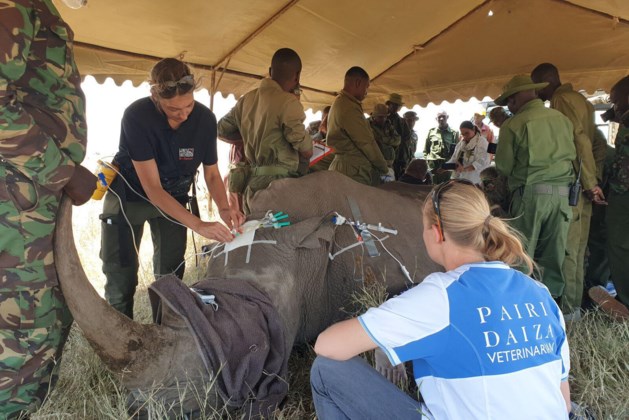Only two of the northern white rhino are still alive. Two females: Najin and her daughter Fatu. Since they are currently unable to reproduce, the species is theoretically extinct. But scientists around the world have been working for years on ways to revive the species. This is how the BioRescue Project, a consortium of scientists trying to save the species using in vitro fertilization techniques, was created.
(Read more below the photo)
Najin and Fatu, the only surviving white northern rhinos. — © AFP
But such techniques are very new when it comes to rhinos. “The technique of embryo transfer is well established for people and domestic animals such as horses and cows. But for rhinos it is completely uncharted territory and everything from the approach to the procedural protocols and the necessary equipment had to be invented, developed, tested and proven in order to use it safely. Together with the team and many professional partners, I developed the devices to find and reach the location needed to insert the tiny embryo into a two-ton animal,” says Thomas Hildebrandt, BioRescue project leader.
It took a total of thirteen attempts to achieve such an IVF pregnancy in rhinos, but it was ultimately successful for the first time. Semen from a southern white rhino, of which thousands are still alive, from an Austrian zoo was used. Embryos were then created in a lab in Italy using eggs from rhino Ellie from Pairi Daiza. Two of those embryos were implanted in the southern white rhino Curra in the Ol Pejeta nature reserve in Kenya.
(Read more below the photo)
The embryos were implanted at Curra in Kenya. — © Pairi Daiza
And Curra turned out to be pregnant. Although things went wrong later. Seventy days after the implantation, the rhino died from an infection by Clostridia, a bacterium found in the soil and which can be fatal to animals.
But an autopsy has now shown that the IVF fertilization was a success. A male calf measuring 6.5 centimeters was found. The development looked good and, according to the scientists, the animal had a 95 percent chance of being born alive.
“It took many years to achieve this and we are happy that today we have proof that the technology works perfectly,” says Hildebrandt. “It is bitter that this step has been confirmed under such tragic circumstances, with the death of the surrogate mother Curra and her unborn calf, but I am confident that this validation of the protocol is a turning point for the survival of the northern white rhino and the health of Central Africa’s ecosystems.”
(Read more below the photo)
The eggs were taken from Ellie, a southern white rhino from Pairi Daiza. — © Pairi Daiza
The next step is now to apply the technique to the embryos of northern white rhinos. There are about thirty of these embryos that were made with eggs from Fatu and two deceased male white northern rhinos. These embryos are currently stored in liquid nitrogen at minus 196 degrees Celsius in Berlin, Germany and Cremona, Italy.
But to achieve such a pregnancy in a northern white rhino, scientists will have to start experimenting again. Fatu and her mother Najin are unable to get pregnant due to their age and health problems. And so a surrogate will be sought. A southern white rhino will therefore have to carry the embryo of two northern white rhinos. Cross-subspecies IVF treatment has never been tried before, but the team is confident it will work. That step could become a reality within about two to three years.
